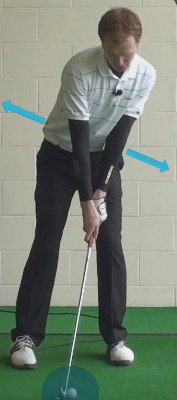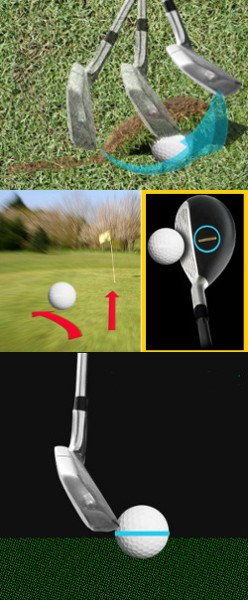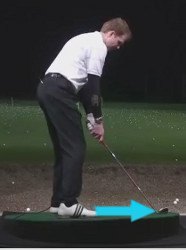
So you know how playing from a downhill lie alters your swing and the ball's flight. Here's what to do about it.
- First of all, use a more lofted club than the distance calls for. If you've got a 150-yard shot and would normally hit a 7-iron, choose an 8- or 9-iron instead. The greater the slope, the less club you should take. And if the green lies well below the spot you're playing from, subtract that yardage from the total. For example, a 10-yard drop will turn 150 yards into 140.
- When setting up to the ball, place your shoulders, hips and knees parallel to the ground, with your spine perpendicular to the slope. Fight the urge to lean back into the hill. You'll feel more weight on your left (lead side) when properly set up, but that's OK in this case.

- Play the ball slightly farther back in your stance than usual. This will help keep the ball down and improve your chances of making good contact.
- The ball will often fly right of where you've lined up, so aim slightly left of target.
- Swing with a smooth tempo – overswinging will throw off your balance.
- Don't try to scoop or lift the ball airborne with your hands. Let the club's loft do the work instead.
 Focus on staying down through the shot. Pick a spot on the back of the ball, laser in on it, and keep your eyes there until the ball is gone.
Focus on staying down through the shot. Pick a spot on the back of the ball, laser in on it, and keep your eyes there until the ball is gone.
Downhill lies are one of golf's biggest challenges, no doubt. Nail the fundamentals and they'll cause you a lot less misery.

Downhill Lie Compensations
The downhill lie is one of the trickiest spots on the entire golf course. While many golfers would prefer to face a downhill lie rather than an uphill lie, the fact is that either one can create problems with the shot at hand. In order to hit a good shot from a downhill lie, you will need to understand how to adjust your technique properly. Once the right adjustments are made, it will then be up to you to execute the swing. It is never going to be easy to hit solid shots from a downslope, but you should get better at this skill with practice and experience.
In this article, we are going to explain the compensations you should make to adjust for a downhill lie. While each golfer is unique, and each player has his or her own way of getting comfortable in this spot, there are some common adjustments which apply to all players across the board. The idea is for you to use the advice offered in this article, along with your own personal preferences and tendencies, in order to develop a method that works perfectly for your game. We hope our advice will help you get over any fears you may have had regarding playing from a downhill lie.
Depending on where you play most of your golf a downhill lie is something you may deal with on a regular basis – or these kinds of shots may be few and far between. Playing golf on a flat course is certainly easier than playing on a hilly layout, but it might not be as much fun. The challenge that comes with golf is a big part of the experience, so don't shy away from hilly or difficult courses just because they might cause your score to rise. Embrace the challenge if difficult shots and enjoy the feeling of taking on a tricky task and pulling off the shot perfectly. Remember, the most satisfying shots you will hit in your golf career are those which presented you with the greatest challenge.
The content below is based on a right-handed golfer. If you happen to play left-handed, please take a moment to reverse the directions as necessary.

The Usual Problems
You may already be familiar with some of the problems you are going to encounter when playing from a downhill lie, but we think it is important to highlight those issues here before moving on. Of course, if you are a beginning golfer, you may not yet know what to expect from a downhill lie. By the time you are finished with this section, you'll have a clear picture of why so many golfers do their best to avoid downhill lies at all costs.
The list of points below contains the usual problems which will be seen when playing from a downhill lie.
- Hitting the ball too far. This might sound like a good problem to have – everyone loves extra distance, after all – but that distance is useless when you aren't able to control it properly. When hitting an approach shot from a downhill like, you will be quite likely to hit the ball too far. This happens because the lie is going to cause the ball to come out on a lower trajectory than normal. For instance, if you hit a seven iron, which may be the correct club for the distance from a flat lie, the ball will come out like it has been struck with a six iron. That lower launch angle is going to lead to a flatter overall flight, and added distance in the end. It can be quite frustrating to see the ball sail toward the target perfectly, only to wind up over the green in the end. There are some technical and strategic adjustments you can make in order to correct for this problem, and we will address both of those later in this article.
- Hitting the ball fat. When on a downslope, it can be difficult to stay down through the shot all the way into impact and beyond. If you lean back at all – which you might be tempted to do in order to maintain your balance – it is likely that the club will catch the turf before you have reached the ball. Needless to say, this is going to result in the shot coming up way short of the target. One of your biggest challenges when hitting from a downhill lie is swinging down along the slope properly. If you can swing the club head down on a path which follows the slope of the ground, it will become much easier to achieve solid contact.
- Pulling the ball to the left. In addition to having trouble hitting the ball the right distance, you may also struggle to get the ball on line when hitting from a downhill lie. Why is this a problem? Simple – it is hard to keep your balance in this situation. If you lose your balance by leaning down the slope, the club will probably swing over the top of the proper line and your shot will be pulled to the left in the end. As is always the case in golf, balance is extremely important when swinging on a downhill lie. Set yourself in a solid position at address and do your best to maintain a stable base all the way down through the ball. It isn't going to be easy to make a balanced swing in this situation, but that is exactly what you need to do in order to hit your target.
- Topping the shot. This might sound like the opposite of hitting the ball fat, but it is actually born of the same mistake. If you allow yourself to lean back away from the target in the downswing, the club is going to shallow out too early. When that happens, there are only two possible outcomes – you will hit the turf prematurely and hit a fat shot, or you will miss the turf and top the ball. When you top the ball, it will scurry along the ground and likely wind up in a bad spot. Not only is this kind of mistake going to hurt on the scorecard, it will likely be a bit embarrassing as well. At the risk of sounding like a broken record, this is another point that comes back to balance. Improve your balance and the issue of topping the ball from a downhill like should become a thing of the past.
If you watch amateur golfers attempt to hit shots from downhill lies, you will see the same mistakes play out over and over again. The four common mistakes from this kind of lie are listed above, and they are all (with the exception of hitting the ball too far) a result – in one way or another – of poor balance. The rest of this article is going to be dedicated to helping you steer clear of the problems we have listed in this section.

Adjusting Your Swing Properly
At this point, we are going to address the technical changes which will need to be made in your swing. You aren't going to remake your entire swing, of course, but you do need to make some meaningful changes if you are going to strike solid, clean shots time after time in this situation. You should think about playing from a downhill lie in the same way you think about playing any other specialty shot. That is to say that you are going to start with a foundation of your standard swing, and then make some adjustments in order to achieve the ideal results.
The best way to explain how you should deal with this type of shot is by providing you with a list of adjustments to consider making. Those adjustments are below –
- Choke down on the grip of the club. This is a pretty standard adjustment, and one which you are going to make almost any time you need to hit a specialty shot. By choking down in this situation, you are going to take out a bit of 'insurance' against hitting the ball fat. You won't have as much club between yourself and the ball when you choke down, meaning it is less likely that you'll catch the turf too soon. This one adjustment is no guarantee of success, of course, but it is a good place to start.
- Widen your stance. As you build your stance, position your feet slightly wider apart than usual for the club you are hitting. This wider stance is one of the main ways that you'll be able to improve your balance in this tricky spot. Also, since a wider stance is going to naturally shorten your turn, you will likely lose a bit of swing speed as a result of this change. That is actually good news, since losing swing speed will cause you to hit the ball shorter than you would have otherwise – hopefully counteracting the extra distance you may have gotten from the lower launch angle.
- Play the ball from the middle of your stance. No matter which club you are holding, you should try playing your shot directly from the middle of your stance. Moving the ball too much in either direction away from the middle of your stance is going to make it difficult to remain balanced. You'll need some lateral movement in order to reach the ball if it is not in the middle of your stance, and lateral movement is your enemy on this shot. You are trying to simplify things to the greatest extent possible here, and hitting your shots from the center of your stance is a good way to do that.
- Set your shoulders to match the slope. This is the last physical adjustment we are going to recommend, and it is a big one. When you settle into your stance, do your best to set your shoulders at an angle which matches up with the angle of the slope. In other words, your left angle is going to be down lower than your right. With any luck, this pre-swing adjustment is going to make it easier for you to swing down the slope and into the ball. Of course, this will only work if you maintain this tilt throughout the swing. Don't let your left shoulder lift up and away from the ground in the takeaway – stay tilted and simply rotate around that axis.
When you add all of the adjustments up, there is plenty to do in order to get ready for a shot from a downhill lie. However, none of these adjustments is particularly difficult or complicated, so you should be able to handle them as long as you spend a bit of time practicing. You can practice three of the four of these adjustments on the range, with the tilting of your shoulders being the only one that will have to wait until you find this situation on the course. Don't try hitting shots on the flat ground of the range with your shoulders tilted to the left, as you could wind up hitting down steeply into the ground. Unless your range has an area of uneven ground where you can practice, the only way to work on that specific adjustment is to wind up on a downslope during a round of golf.



 Focus on staying down through the shot. Pick a spot on the back of the ball, laser in on it, and keep your eyes there until the ball is gone.
Focus on staying down through the shot. Pick a spot on the back of the ball, laser in on it, and keep your eyes there until the ball is gone.



